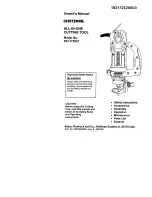
EN - 11
In any case, cutting around pavements,
foundations, walls, etc. can cause
greater wear than normal to the line.
d. Cutting around trees
Walk round the tree from left to right,
approaching the trunks slowly so as not to strike
the tree with the line and keeping the cutting
line head tilted forward slightly. (Fig. 17)
Remember that the nylon line could lop off or
damage small shrubs and that the impact of the
nylon line against the trunk of bushes or trees
with soft bark could seriously damage the plant.
6.4.1.b
Adjusting the length of the
cutting line head during work
This machine is fitted with a “Tap & Go” head.
To release more line, tap the cutting line head
against the ground with the engine at top speed:
the line will be released automatically and the
knife will cut off the excess length (Fig. 18).
6.4.1.c
3-point blade
Start cutting above the undergrowth and then
move down with the scything blade so as to
cut the brush into small pieces (Fig. 19).
6.4.1.d
Saw blade (if permitted)
When using the saw blade,
where permitted, the specific guard
must always be fitted (cap. 4.3.3). The
blade must always be well sharpened
to reduce the risk of kickback.
When felling small trees, estimate the
direction in which the cut tree will fall, also
taking the wind direction into consideration.
To get a good result when felling small
trees, the cut must be made with a rapid
movement towards the branch or trunk to
be cut, with the engine at maximum revs.
Do not use the right-hand area of the
blade because there is a high risk of
kickback or the blade seizing up, due
to the direction of rotation (Fig. 20).
6.5 ADVICE ON OPERATION
• During use, the engine should be stopped
(paragraph 6.5) and weeds must be removed
periodically that have wrapped around the
machine to prevent the drive tube overheating
(fig. 1.B) because of grass lodged under
the guard of the cutting means (fig. 1.D).
Remove the lodged grass with a screwdriver
to allow the drive tube to cool properly.
NOTE
Avoid using the machine at full
power for the first 6- 8 working hours.
IMPORTANT
Stop the engine ( par.
6.5) when moving between work areas.
6.6 STOP
To stop the machine:
•
Release the throttle control lever (fig. 12.B;
fig. 13.B) and allow the engine to run at
minimum speed for a few seconds.
•
Turn switch (fig. 12.A; fig. 13.A) to «O».
•
Wait for the cutting means to stop
and then fit the blade guard.
When you have reduced throttle
speed to a minimum, it will take a few
seconds for the cutting means to stop.
The engine may be very hot immediately
after it is shut down. Do not touch. The
engine can cause burn injuries.
6.7 AFTER OPERATION
• Clean all traces of dust and debris
off the machine, (par. 7.4).
•
Check there are no loose or damaged
components. If necessary, replace
the damaged components and tighten
any screws and loose bolts.
IMPORTANT
Stop the engine ( par. 6.5),
remove the spark plug cap (fig. 12.H; fig.
13.H) and apply the blade protection device
whenever you leave the machine unattended.
7. ROUTINE MAINTENANCE
7.1 GENERAL
IMPORTANT
The safety regulations to
follow during machine use are described
in Chapter 2. Strictly comply with these
instructions to avoid serious risks or hazards.
Before performing any
maintenance operations:
• Stop the machine;
•
Wait for the cutting means to
come to a complete stop;
•
Remove the spark plug cap
(fig. 12.H; fig. 13.H);
•
Wait until the engine is sufficiently cold;






































